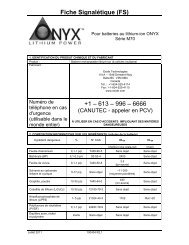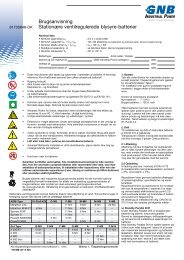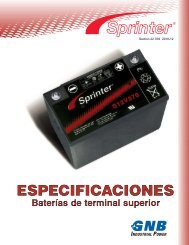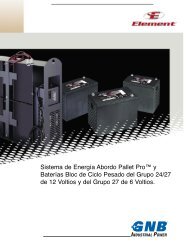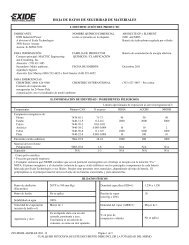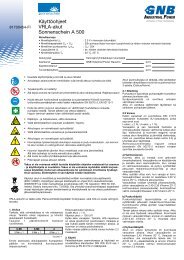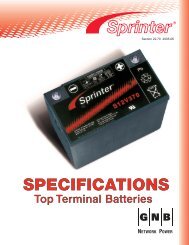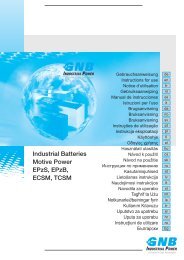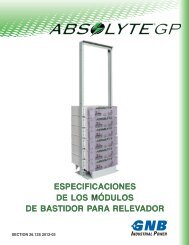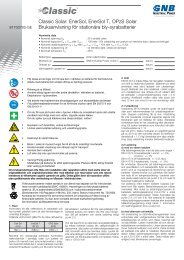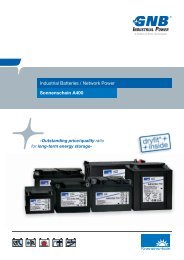You also want an ePaper? Increase the reach of your titles
YUMPU automatically turns print PDFs into web optimized ePapers that Google loves.
<strong>Golf</strong> <strong>Cart</strong><br />
Battery Maintenance Manual
Index<br />
<strong>Exide</strong> <strong>Golf</strong> <strong>Cart</strong> Batteries ......................................................2<br />
Summary of <strong>Golf</strong> <strong>Cart</strong> Battery Care ......................................3<br />
Installing ................................................................................4<br />
Charging ................................................................................5<br />
Watering ................................................................................7<br />
Cleaning ................................................................................9<br />
Testing .................................................................................10<br />
Off-Season Storage ............................................................11<br />
Caution ................................................................................11<br />
Poison/Danger ....................................................................12
1<br />
EXIDE ® GOLF CART<br />
Day-In, Day-Out Durability<br />
And Performance<br />
Ordinary golf carts and other electric vehicles require<br />
extraordinary batteries to keep them humming worry free.<br />
Since nothing ruins a day on the links like a dead golf cart,<br />
<strong>Exide</strong> makes an advanced line of golf cart and electric<br />
vehicle batteries designed for increased cycle life and<br />
reduced maintenance time. All this backed by <strong>Exide</strong>’s strong<br />
nationwide warranty program means you can worry more<br />
about your swing and less about getting to the next hole.
Specifications<br />
BCI<br />
GROUP BATTERY<br />
SIZE TYPE VOLTS RC MINUTES @ 75A<br />
GC2 GC-110 6 110— Avg. Perf. Min.<br />
GC2 GC-110-Z 6 110 — Avg. Perf. Min.<br />
GC2 GC-135 6 135 — Avg. Perf. Min.<br />
GC2 GC-145 6 145 — Avg. Perf. Min.<br />
GC8 GC8V-110 8 110* — Avg. Perf. Min.<br />
GC8 GC8V8-118 8 118* — Avg. Perf. Min.<br />
Specifications<br />
* Minutes @ 56 amps to 7.0 volts<br />
OVERALL DIMENSIONS (INCHES)**<br />
L W H<br />
GC-110 10-5/16 7-1/8 10-7/8<br />
GC-110Z 10-5/16 7-1/8 10-5/16<br />
GC-135 10-5/16 7-1/8 10-7/8<br />
GC-145 10-5/16 7-1/8 11-5/8<br />
GC8V-110 10-5/16 7-1/8 10-7/8<br />
GC8V8-118 10-5/16 7-1/8 10-7/8<br />
** Specifications are subject to<br />
change without notice.<br />
2
Summary Of <strong>Golf</strong> <strong>Cart</strong><br />
Battery Care<br />
1. The battery carrier and hold-down should be free of<br />
corrosion and rust, and painted with a corrosion-resistant<br />
paint. Frayed or worn out cable connectors should be<br />
replaced. All connectors should be clean and tight, and a<br />
thin coating of non-metallic grease or protective spray<br />
should be applied to ward off future corrosion.<br />
2. Batteries should be recharged after each day’s use.<br />
Charging between rounds is acceptable if it is feasible<br />
to do so. Do not send out a cart unless the batteries are<br />
in a good state of charge.<br />
3. When adding water, do not overfill; this can result in loss<br />
of electrolyte. Check tap water for impurity content. Do<br />
not use creek or well water due to the high iron and<br />
mineral content.<br />
4. Keep golf cart batteries clean and free of acid spillage,<br />
dirt and grime. Clean batteries with a bristle brush using<br />
water and baking soda. Rinse with water.<br />
5. Check batteries periodically to see that they are in a<br />
good state of charge. Acid specific gravity should not<br />
vary more than 50 points between cells.<br />
6. Store batteries during off season in an unheated<br />
area. Fully charge batteries before storing. Check<br />
periodically and recharge if batteries go below 1.220<br />
specific gravity. Do preventative maintenance before<br />
putting carts back in service.<br />
3
Installing<br />
Check Polarity<br />
The first step to ensure proper installation of a new set<br />
of batteries in a golf cart is to observe how the old set<br />
of batteries was installed, and the position of the cable<br />
connectors. This will keep you from installing the new<br />
batteries in a reverse position.<br />
Remove Corrosion<br />
After removing the old set of batteries, clean the battery<br />
carrier and battery hold-down to remove all corrosion and<br />
rust. The clean parts should then be painted with a corrosion<br />
resistant paint.<br />
Visual Inspection<br />
Check batteries before installing to ensure that containers,<br />
covers and terminals were not broken or damaged in transit.<br />
Cable Connectors<br />
When old cable connectors are being reused, soak them<br />
in a bucket of water to which one cup of baking soda has<br />
been added. Wipe the cable connectors clean and dry,<br />
then wire brush the connector ends until the metal shines.<br />
If clamp-on terminals are used, use a post-type brush to<br />
clean the INSIDE of the terminal connectors. The battery<br />
terminals should be cleaned until the lead shines. Inspect<br />
cable connectors before reinstalling; replace those that<br />
have broken or frayed wires or loose terminal connectors.<br />
Install Hold-Down<br />
Install the battery hold-down making certain it is pulled<br />
snug enough to keep the batteries from bouncing in the<br />
carrier. Don’t overtighten as this can crack the batteries.<br />
Install Connectors<br />
Install the cable connectors to the battery terminals (using<br />
a hand wrench, for a good tight connection). It is advisable<br />
to tape (plastic electrical tape) one end of the wrench to<br />
avoid a short if the wrench should hit an opposite terminal<br />
while installing connectors. Apply a coating of non-metallic<br />
grease or protective spray to all connectors to help<br />
minimize future corrosion.<br />
First Charge<br />
Before sending the cart out on the course, give the<br />
batteries a full charge. This acts as an equalizing charge<br />
and ensures that all batteries in the cart are in a good state<br />
of charge. New batteries should be given a full charge<br />
before their first use because it is difficult to know how long<br />
the batteries have been in storage without a charge.<br />
4
Limit use of new batteries between charges for the first five<br />
cycles. New batteries and old batteries that have been in<br />
storage are not capable of their rated output until they have<br />
been discharged and charged several times.<br />
When temperatures are below 60ºF, new batteries should<br />
be given an extra, full charge once a week. The ampere<br />
hours of energy that batteries can deliver and their charge<br />
acceptance varies directly with battery temperature.<br />
Charging<br />
Chargers<br />
When charging golf cart batteries, follow the instructions<br />
provided by the manufacturer of the chargers you are<br />
using. Most golf cart battery chargers on the market today<br />
are designed to bring a normally discharged battery back to<br />
full or near full charge in a given time period. The state of<br />
charge depends on the type of play and the number of<br />
holes for which the golf cart was used.<br />
Hard Use<br />
Where golf carts are used “hard” for 36 holes every day,<br />
and possibly more than 36 holes some days, there is a<br />
good chance that the charger cannot keep up with the<br />
amount being discharged from the battery. In such a case,<br />
the batteries start falling into a low state of charge. A<br />
charger could be working perfectly, but if you do not get the<br />
carts on charge until 10:00 p.m. and off at 6:00 a.m., the<br />
chances are good that you did not get sufficient charge into<br />
the batteries. Hard use carts should be charged for at least<br />
8 hours to keep up with the amount discharged.<br />
Catch-Up Charge<br />
In cases where carts are used hard and begin falling<br />
behind, it may be necessary to employ a catch-up charge.<br />
On a rainy day or off day, when carts do not go out, they<br />
should be checked for state of charge. Any batteries that<br />
are not in good state of charge should be recharged.<br />
As long as the charger tapers down to the specified finish<br />
charge rate near the end of the charge cycle, the batteries<br />
should be at full charge. All cells in a set of batteries do not<br />
react identically to the same discharge and charge current.<br />
In a normal charge, the last one to three hours at the low<br />
finish charge rate equalize the cells for better battery life.<br />
5
Catch-Up Charge Recommendation<br />
State of Charge Charge<br />
1.260 to 1.280 sp.gr.* none needed<br />
1.240 to 1.260 sp.gr.* 4 hours<br />
1.220 to 1.240 sp.gr.* 8 hours<br />
below 1.220 sp.gr.* 12 hours<br />
Effects Of AC Line Voltage On<br />
The Average <strong>Golf</strong> <strong>Cart</strong> Battery Charger<br />
AC Line Voltage Starting<br />
(under load) Rate<br />
115 25.0 amps<br />
110 22.5 amps<br />
105 19.0 amps<br />
100 16.0 amps<br />
* Specific Gravity<br />
Amount Of Charge<br />
To avoid getting batteries into a low state of charge, golf<br />
carts should be put on charge early enough in the evening<br />
to allow for the full-time schedule of the charger. Do not<br />
charge batteries every day that the golf cart is not used.<br />
By so doing, you will overcharge the batteries shortening<br />
the battery life. Overcharging batteries corrodes the<br />
positive grids resulting in the disintegration of the positive<br />
grid structure.<br />
For every day use, turn the charger on and check to<br />
see if the meter needle jumps upward and then tapers<br />
down to the finish rate area within 15 minutes. This will<br />
provide a very simple means of verifying that the batteries<br />
were charged.<br />
AC Power<br />
Available AC power has a direct effect on the initial<br />
output rate of the charger. <strong>Golf</strong> cart battery chargers are<br />
designed to give their rated output when connected to AC<br />
line voltage of 115 volts. If there is insufficient AC power<br />
available (too small a transformer installation to supply<br />
the power requirements when all chargers are operating<br />
at the same time), line voltage will drop significantly below<br />
115 volts. The result could be undercharged batteries. It<br />
is suggested you contact your local power company for a<br />
survey of your installation.<br />
6
Rotating <strong>Cart</strong>s<br />
It is important to remember that golf carts should be rotated<br />
so that the last carts put on charge at night are NOT the first<br />
out in the morning. Otherwise some carts could get an<br />
insufficient charge while others may become overcharged.<br />
Proper rotation of cars not only keeps the batteries in<br />
balance but keeps your fleet in balance.<br />
Watering<br />
Electrolyte<br />
The electrolyte in lead-acid storage batteries is a solution<br />
of sulfuric acid and water. The sulfuric acid portion of the<br />
electrolyte does not evaporate, but the water portion must<br />
continually be replaced because of loss due to charging<br />
and evaporation.<br />
Add Only Water<br />
It is not necessary during the normal life span of a battery<br />
to add sulfuric acid. If a battery is spilled, causing the<br />
loss of a quantity of the acid, then and only then should<br />
acid be added. This however should be done ONLY by<br />
an experienced battery technician.<br />
Type Of Water To Use<br />
Mineral Content<br />
The average 6-volt golf cart battery contains approximately<br />
6.8 quarts of electrolyte. During the normal life span of the<br />
battery, this original volume is added in water at about 2 1/2<br />
times. This means that each battery in its normal life span<br />
has had about 16 quarts of water added. If you add water<br />
that has a high mineral content, there may be a cumulative<br />
adverse effect on battery performance. If you choose to<br />
use tap water, it is suggested that you contact your local<br />
water department requesting an analysis to see if the<br />
mineral content is within limits for use in lead-acid storage<br />
batteries.<br />
Creek water and well water generally have a high impurity<br />
content and should not be used in storage batteries.<br />
7
Recommended Allowable Impurities In Water<br />
Impurity Calculated as Parts per Million<br />
Color Clear & White<br />
Suspended Trace<br />
Total Solids 100<br />
Calcium &<br />
Magnesium<br />
Oxides<br />
CaO & MgO 40<br />
Iron Fe 4.0<br />
Ammonia NH3 5.0<br />
Organic &<br />
Volatile Matter 50<br />
Nitrates NO3 10<br />
Nitrates NO2 5.0<br />
Chloride C1 5.0<br />
Level Indicator<br />
Most golf cart batteries have an indicator ring inside the<br />
filling well showing the normal level for adding water. Add<br />
water to a level 1/4 to 1/8 inch below the indicator ring.<br />
Electrolyte Level<br />
The level of electrolyte should NEVER be allowed to go<br />
below the top of the plates — this can cause permanent<br />
damage to the exposed portion of the plates. If you cannot<br />
see the electrolyte covering the separators before the<br />
batteries are put on charge, add enough water to cover<br />
the top of the separators. After the charge is completed,<br />
relevel with water to the normal level.<br />
Avoid overfilling when adding water to the batteries.<br />
The problem with overfilling is that while charging,<br />
acid is pumped out and lost, reducing the capacity of<br />
the battery. This will also increase corrosion to metal<br />
parts of the battery.<br />
8
When To Add Water<br />
It is recommended that water be added to batteries near the<br />
end of the charge or after taking them to charge. Be certain<br />
to replace the vent caps after watering so electrolyte does<br />
not splash out while the golf cart is being used.<br />
Generally, water must be added to golf cart batteries about<br />
every 30 days. This is governed greatly<br />
by the amount of use, charging and<br />
heat exposure. It is suggested that<br />
a few vent caps be removed<br />
at least every week to<br />
check and see if the<br />
batteries need water.<br />
Cleaning<br />
Current Leakage<br />
If a coating of acid soaked dirt accumulates on the battery<br />
top, an electrical path will be created between the terminals.<br />
This in turn may cause a leakage of current, which reduces<br />
the operating efficiency and is detrimental to the life<br />
expectancy of the battery.<br />
Washing<br />
Batteries on golf carts should be kept clean and free of<br />
acid spillage, dirt and grease. This can be accomplished<br />
by washing the batteries with a water hose after water has<br />
been added to the batteries. Make certain all vent caps are<br />
securely in place before washing the batteries to prevent<br />
significant amounts of dirt or foreign matter from getting<br />
into the battery cells.<br />
When batteries have an accumulation of grime that fails to<br />
wash off with a hose, the battery tops should be cleaned<br />
with a solution of water and baking soda (approximately one<br />
cup per bucket of water). After scrubbing the battery tops<br />
with a stiff bristle brush, rinse off with water.<br />
9<br />
WATER<br />
Bicarbonate<br />
Of Soda<br />
BAKING<br />
SODA<br />
WATER
Testing<br />
What To Check<br />
When a set of golf cart batteries is relatively new and<br />
the cart is not performing properly, check to see if they<br />
were fully charged before the cart was set out on the<br />
course. If the batteries were properly charged and trouble<br />
persists, do not discard the entire set of batteries. The<br />
chances are good that only ONE battery of the set needs<br />
to be replaced.<br />
Using a battery hydrometer, test each battery individually,<br />
comparing the three cell readings of each battery.<br />
If the variation between the highest and lowest cell readings<br />
in any one battery is .050 (50 gravity points) or greater,<br />
there is reason to suspect a weak or failing cell. This test is<br />
best accomplished with the batteries in a full state of charge<br />
and all cells equal in electrolyte level.<br />
Load Test<br />
Connect a 75-amp load tester to the fully charged set<br />
of batteries and test each battery in the set with a 6-volt<br />
voltmeter while under load. A weak or failed battery in the<br />
set will show up on the voltmeter. Let the set discharge<br />
to an overall voltage of 31.5 volts. At this point, if they<br />
discharged less than 40 minutes to 31.5 volts, test each<br />
battery individually with a voltmeter, because chances<br />
are there is a bad battery in the system. If a failed battery<br />
cannot be found and the fully charged set of batteries<br />
discharged only 40 minutes to a voltage of 31.5 volts, the<br />
golf cart probably will not make 18 holes of golf and the<br />
entire set of six batteries should be replaced.<br />
When it is necessary to replace one or two batteries in a<br />
cart, it is advisable to replace with batteries comparable in<br />
age with those presently in the cart. By so doing, you keep<br />
a better balance of age and remaining capacity of the<br />
batteries in each cart.<br />
10
Off-Season Storage<br />
Clean Tops<br />
<strong>Golf</strong> cart batteries are generally stored connected in the golf<br />
cart. Before putting cars up for off-season storage, be<br />
certain the tops of the batteries are washed clean—this will<br />
help to reduce the amount of self-discharge on the batteries.<br />
Self-Discharge<br />
Fully charge the batteries, then store in an unheated area.<br />
Heat increases the amount of self-discharge while cold<br />
reduces the stand loss characteristics of the storage battery.<br />
Physically sound, fully charged batteries, stored at 0ºF,<br />
self-discharge very little over a four-month period. On the<br />
other hand, if the same batteries were stored at 80ºF, they<br />
would need to be charged about once a month.<br />
Batteries in storage should be checked periodically and<br />
when the gravity drops to 1.220 specific gravity. by<br />
hydrometer reading, they should be brought back to full<br />
charge.<br />
Where a load tester (75 amp) is available, recharge the<br />
batteries to full charge then proceed with the 75 amp<br />
discharge, recording the minutes run to 31.5 volts. The<br />
carts should now be classified by the number of minutes<br />
they deliver on the 75 amp test. Batteries that will give<br />
approximately 70 minutes or more are in good condition.<br />
Where a set of batteries will deliver only 40 minutes or less<br />
and there is not a failed battery in the set, the set should be<br />
replaced. After checking all batteries and classifying<br />
according to minutes delivered, the batteries should be<br />
removed from the cart and the maintenance procedure<br />
outlined under installing in this manual should be followed.<br />
Caution<br />
Explosive Gases<br />
The gases generated within a storage battery cell on charge,<br />
a combination of oxygen and hydrogen, may be ignited by<br />
an open flame or spark in the vicinity of the battery.<br />
A match should not be used to provide light for checking<br />
the level of electrolyte. Care should be exercised while<br />
working in the vicinity of the battery test because a short<br />
circuit produced by a tool could ignite the battery gases.<br />
Another possible danger is a spark produced by static<br />
electricity.<br />
ALWAYS WEAR EYE PROTECTION WHEN<br />
WORKING NEAR BATTERIES AND SKIN<br />
PROTECTION WHEN HANDLING BATTERIES<br />
OR ELECTROLYTE.<br />
11
Poison/Danger<br />
Sulfuric Acid<br />
Batteries contain sulfuric acid and can cause severe<br />
burns. Avoid contact with skin, eyes and clothing.<br />
If battery acid is spilled, immediate action is required<br />
to check or eliminate its corrosive effects:<br />
External: Flush with cold water.<br />
Eyes: Flush with cold water for 15 minutes, then get<br />
medical attention immediately. Remove contaminated<br />
clothing immediately, including shoes.<br />
Internal: Drink large quantities of water. Do not induce<br />
vomiting. Call physician immediately.<br />
<strong>Cart</strong> Or Clothing: Wash immediately with cold water<br />
and neutralize the area with a baking soda or household<br />
ammonia solution. Bleaching or other damage can result.<br />
CORROSIVE<br />
12
<strong>Exide</strong> uses a comprehensive business<br />
approach to recycling called Total<br />
Battery Management (TBM). TBM<br />
includes manufacturing and distribution<br />
of lead-acid batteries, collection of<br />
spent batteries, reclamation of battery<br />
materials and use of those materials in<br />
new batteries.<br />
<strong>Exide</strong> Technologies recycles sufficient<br />
lead tonnage to make the Company one<br />
of the largest secondary lead recyclers<br />
in the world, returning the materials to<br />
new product and diverting them from<br />
the waste stream. <strong>Exide</strong> Technologies<br />
batteries are recyclable.<br />
For more information and nationwide warranty terms<br />
visit us at StartPositiveStayPositive.com or<br />
call 1-800-START-IT<br />
©2011 <strong>Exide</strong> Technologies. <strong>Exide</strong> Technologies Milton, GA 30004 U.S.A.<br />
MKTG2513 50K 01/11 DP




